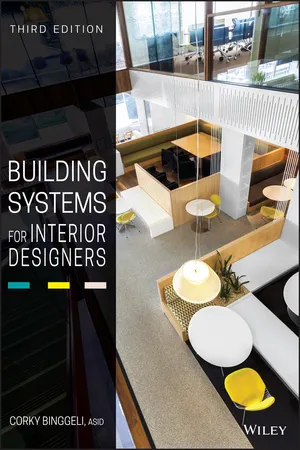
Building Systems for Interior Designers
Corky Binggeli
- English
- ePUB (mobile friendly)
- Available on iOS & Android
Building Systems for Interior Designers
Corky Binggeli
About This Book
The ultimate interior designer's guide to building systems and safety
Building Systems for Interior Designers, Third Edition is the single-source technical reference that every designer needs, and an ideal solution for NCIDQ exam preparation. Now in its third edition, this invaluable guide has been updated to better address the special concerns of the interior designer within the context of the entire design team. New coverage includes the latest information on sustainable design and energy conservation, expanded coverage of security and building control systems, and a new and expanded art program with over 250 new illustrations. Covering systems from HVAC to water to waste to lighting, this book explains technical building systems and engineering issues in a clear and accessible way to help interior designers communicate more effectively with architects, engineers, and contractors.
Professional interior design is about much more than aesthetics and decorating, and technical knowledge is critical. Before the space is planned, the designer must consider the mechanical and electrical equipment, structural system, and building components, and how they impact the space. This book shows you how to evaluate these complex factors, and how each affects your work throughout the building.
- Consider how site conditions and structural systems affect interior design
- Design functionally for human health and safety
- Factor water, electrical, and thermal systems into your design plans
- Examine the ways in which lighting and acoustics affect the space
The comfort, safety, and ultimate success of a project depend upon your knowledge of building system and your coordination with architects and engineers. Building Systems for Interior Designers, Third Edition provides the comprehensive yet focused information you need to excel at what you do best.
Frequently asked questions
Information
PART I
THE BUILDING, THE ENVIRONMENT, AND HEALTH AND SAFETY
- Chapter 1, “Environmental Conditions and the Site,” looks at climate change, energy sources and consumption, and how site conditions affect building design.
- Chapter 2, “Designing for the Environment,” investigates the building envelope and the role of insulation in heat flow. Energy efficient design, the building design process, and sustainable design are introduced.
- Chapter 3, “Designing for Human Health and Safety,” addresses the interaction of the human body with the built environment and how building codes protect us.
A common thread … is the attitude that buildings and sites should be planned and developed in an environmentally sensitive manner, responding to context and climate to reduce their reliance on active environmental control systems and the energy they consume. (Francis D.K. Ching, Building Construction Illustrated (5th ed.), Wiley, 2014, Preface)
1
Environmental Conditions and the Site
A building’s form, scale, and spatial organization are the designer’s response to a number of conditions—functional planning requirements, technical aspects of structure and construction, economic realities, and expressive qualities of image and style. In addition, the architecture of a building should address the physical context of its site and the exterior space. (Francis D. K. Ching and Corky Binggeli, Interior Design Illustrated [3rd ed.], Wiley 2012, page 4)
INTRODUCTION
Table of contents
- Cover
- Title page
- Copyright
- Preface
- Acknowledgements
- PART I THE BUILDING, THE ENVIRONMENT, AND HEALTH AND SAFETY
- PART II BUILDING COMPONENTS
- PART III ACOUSTICS
- PART IV WATER AND WASTE SYSTEMS
- PART V HEATING, COOLING, AND VENTILATION SYSTEMS
- PART VI ELECTRICAL AND LIGHTING SYSTEMS
- PART VII FIRE SAFETY, CONVEYANCE, SECURITY, AND COMMUNICATIONS
- Bibliography
- Index
- EULA